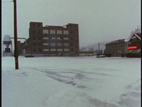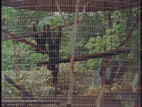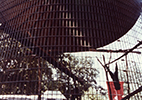Four Shadows (Elective Affinities, Part III)
- Larry Gottheim |
- 1978 |
- 64 minutes |
- COLOR |
- SOUND
Like constellations wheeling round, a double chain of four image segments and four sound segments wheel past each other in 16 combinations - a family of Gibbon apes, a landscape measured, a shadowed diagram after Cezanne, a wintry urban scene, a text by Wordsworth, a climactic scene from Debussy's opera Pelleas et Melisande .... The stately ceremony can generate rich sensuous cinematic pleasure as well as a free-flowing stream of associations. Containment and flowing free - these are some of the issues. The third film in the Elective Affinities cycle.
Exhibition: Biennial Exhibition, Whitney Museum of American Art, 1978; Berlin Film Festival.
"Four four-minute image sections and four four-minute sound sections are linked in all combinations of the sound sections with each of the image sections. This established affinities between each of the image sections to the others, and the sound sections to each other. The image sections are: surveyors measuring the land near my house as seen through an old window, a family of Siamang Gibbon apes in the Washington zoo, an industrial site, and a page turned from a book on Cézanne's composition showing a diagram of his painting Mardi Gras, filmed against bright leaves. The sound sections are: a dramatic scene from Debussy's opera 'Pelléas et Mélisande', a passage from William Wordworth's autobiographical poem "The Prelude," sounds from rowing on a lake at night, and the sounds of the apes vocalizing.
Some of these were thought about or created before the idea of the film came about, and some were expressly added. The final material was the Cézanne images This section might present the most difficulty for the viewer, but actually allows for the deepest penetration into the heart of the film. The diagram is an analog of the film as is the zoo cage and an industrial building with it four rows of four windows.
Since each element is repeated four times, there is constant recontextualizing of the material. The viewer can 'play' elements of material from other sections that have affinities with what is on the screen and sound track at a given moment. Everything is deeply reverberant with issues that are connected with my life and work but also can open associations that are unique to each viewer. The theme of "nature" that is present in my earlier work is here, too, but now made more complex. Other issues relate to music, language, painting, the relation of humans to animals and the earth.
The Wordsworth passage is read each time by four different readers for whom English is not the native language. Each is a kind of portrait of the reader. They include Jonas Mekas, Peter Kubelka, Klaus Wyborny, Heinz Emigholz, Taka Iimura." (Larry Gottheim)




